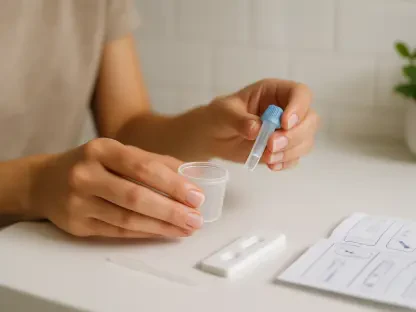Setting the Stage for Change in Women’s Health
Imagine millions of women grappling with the debilitating effects of menopause—hot flashes disrupting daily life, night sweats robbing them of sleep, and mood swings straining relationships—yet hesitating to seek relief due to fears of severe health risks. This scenario reflects the reality for many navigating menopausal hormone therapy (MHT), a treatment once widely embraced but now shrouded in caution due to long-standing warnings. The U.S. Food and Drug Administration (FDA) has signaled a potential shift, announcing plans to reassess the black box warnings on estrogen-containing drugs used for menopausal symptom relief. This move could redefine how these therapies are perceived, prescribed, and accessed, marking a critical juncture in women’s health care.
The current landscape of MHT is shaped by a complex interplay of historical data, regulatory oversight, and evolving medical understanding. Once a cornerstone of menopause management, MHT usage plummeted after studies in the early 2000s linked it to serious risks, including breast cancer and cardiovascular issues. Today, with usage rates hovering at a mere fraction of their peak, the industry stands at a crossroads, balancing the need for effective symptom relief against the imperative of patient safety. Key players in the pharmaceutical sector, alongside regulatory bodies, are keenly observing how updated guidelines might reshape market dynamics and restore confidence in these therapies.
Overview of Menopausal Hormone Therapy (MHT) Landscape
Menopausal Hormone Therapy remains a pivotal tool in women’s health, designed to alleviate the often severe symptoms of menopause by replenishing estrogen levels, sometimes combined with progestin. Its significance lies in offering relief from hot flashes, vaginal dryness, and other challenges that can profoundly affect quality of life during this transitional phase. Beyond symptom management, MHT also plays a role in preventing bone loss, a critical concern for postmenopausal women at risk of osteoporosis.
The therapy is available in various forms, including tablets, patches, sprays, and creams, catering to diverse patient needs and preferences. Oral tablets provide systemic relief, while transdermal patches and sprays offer alternatives with potentially different risk profiles due to how they are absorbed. Localized options like vaginal creams target specific symptoms with minimal systemic impact. Despite these options, MHT usage has seen a dramatic decline since its peak in the late 1990s, largely due to safety concerns raised by landmark studies, leading to stringent FDA oversight and the introduction of black box warnings in 2003.
Major pharmaceutical companies continue to dominate the MHT market, supplying a range of products while navigating the reputational challenges tied to past controversies. Regulatory scrutiny by the FDA has shaped product labeling and prescribing practices, often prioritizing caution over accessibility. This historical context underscores the delicate balance the industry faces today—ensuring safety while addressing the unmet needs of women who could benefit from these therapies under updated, evidence-based guidelines.
Evolving Science and Trends in MHT
Emerging Evidence and Expert Consensus
Recent scientific advancements have reshaped the understanding of MHT, moving away from a one-size-fits-all risk assessment to a more nuanced perspective. Reanalyses of data from the Women’s Health Initiative (WHI) study, initially responsible for highlighting severe risks, now suggest that outcomes vary significantly based on factors like age, timing of therapy initiation, and delivery method. For instance, women under 60 or within a decade of menopause onset often experience benefits with lower risks compared to older cohorts.
This evolving evidence has spurred a growing consensus among experts for personalized treatment approaches. Many advocate that MHT can be both safe and beneficial when tailored to individual profiles, particularly emphasizing its protective effects on bone health and potential cardiovascular benefits for younger postmenopausal women. Professional bodies and clinicians are increasingly vocal about the need for updated guidelines that reflect these distinctions rather than applying broad, fear-inducing warnings.
A significant point of discussion is the call for differentiated labeling, especially for low-risk options such as vaginal creams, which have minimal systemic absorption and thus pose less threat of conditions like cancer or blood clots. Experts argue that current blanket warnings fail to account for these variations, potentially deterring women from safe and effective treatments. This push for precision in communication is central to ongoing dialogues with regulatory authorities.
Usage Patterns and Societal Impact
Data reveals a stark decline in MHT usage over recent decades, dropping from over 25 percent of postmenopausal women in the late 1990s to roughly 4 percent in current estimates. This sharp reduction reflects widespread apprehension following early risk reports, fundamentally altering how women and healthcare providers approach menopause management. The result is a significant portion of women enduring untreated symptoms, often without viable alternatives.
The societal ramifications of this trend are profound, with many experiencing a diminished quality of life due to persistent hot flashes, sleep disturbances, and emotional challenges. This gap in care highlights a critical public health issue, as untreated menopausal symptoms can lead to broader impacts on mental health, workplace productivity, and personal relationships. The burden falls heaviest on those who lack access to informed medical advice or alternative therapies.
Looking ahead, updated FDA warnings could reverse this downward trajectory in MHT prescriptions. If revised guidelines better communicate the balance of risks and benefits, healthcare providers might feel more confident in recommending therapy to eligible patients. Such a shift could herald a gradual increase in usage, particularly among women who stand to gain the most from early intervention, potentially reshaping societal attitudes toward menopause treatment.
Challenges in MHT Perception and Access
The current black box warning on MHT, while intended to protect, has fostered unintended consequences that hinder access to care. Many women, upon encountering the severe cautions about risks like cancer and strokes, opt against therapy out of fear, even when their personal risk profile might be low. This apprehension is compounded by a lack of clear, accessible information about how risks differ across age groups and therapy forms.
Physicians, too, face challenges, often exhibiting hesitancy to prescribe MHT due to liability concerns and the broad, alarming nature of existing warnings. This reluctance creates a barrier to effective treatment, particularly for women with severe symptoms who could benefit significantly from therapy. The result is a healthcare environment where caution sometimes overshadows clinical need, leaving many patients underserved.
Addressing these challenges requires a multifaceted approach, including enhanced education for both providers and patients about the varying risk profiles associated with MHT. Initiatives to improve dialogue around personalized medicine could empower women to make informed choices, while updated training for clinicians might reduce prescribing hesitancy. Bridging this gap between risk communication and access remains a critical hurdle for the industry and regulatory bodies alike.
Regulatory Reconsideration of Black Box Warnings
The FDA’s recent announcement to reevaluate the black box warning on MHT, in place since 2003, marks a significant step toward aligning regulations with current scientific understanding. Initially introduced due to identified risks such as breast cancer, strokes, and dementia in older women, the warning has long been a source of contention among experts who argue it overgeneralizes the dangers across all therapy forms and patient demographics.
Driving this reconsideration is a wealth of newer data, alongside input from recent expert meetings, suggesting that not all MHT applications carry equivalent risks. For example, localized treatments like vaginal estrogen show minimal systemic effects, prompting calls for their exemption from the most severe warnings. The FDA’s rationale centers on ensuring that labeling reflects these distinctions, potentially easing restrictions on certain products while maintaining necessary cautions for others.
The potential impact of this regulatory shift is substantial, likely influencing clinical guidelines and boosting confidence among hesitant providers. Public trust in the safety of hormone therapy could also see a revival if updated warnings are perceived as balanced and evidence-based. This reassessment represents an opportunity to recalibrate how MHT is integrated into women’s health strategies, prioritizing both safety and accessibility.
Future Directions for MHT and Women’s Health
As the FDA contemplates updates to MHT warnings, the anticipated outcomes include a renewed confidence in using these therapies for symptom management and recognizing protective benefits like reduced bone loss. Such changes could encourage more women to seek treatment, particularly those in the early stages of menopause where benefits often outweigh risks. This shift might also spur pharmaceutical innovation, with companies developing more tailored or lower-risk hormone products.
However, emerging concerns loom on the horizon, notably the rise of online access to hormones without medical oversight. This trend poses risks, especially for women with pre-existing conditions like high blood pressure or obesity, who may face heightened dangers without proper guidance. Regulatory clarity will be essential to mitigate these issues, ensuring that access does not come at the expense of safety.
The broader trajectory for MHT also hinges on continued research and global health trends impacting women’s care. Advances in personalized medicine, coupled with international efforts to prioritize menopausal health, could further refine treatment approaches. The role of innovation—whether through novel delivery methods or enhanced patient education—will be critical in shaping a future where MHT is both effective and trusted, aligning with the evolving needs of aging populations worldwide.
Reflecting on a Path Forward
The journey toward updating the FDA’s black box warnings on menopausal hormone therapy unfolds as a pivotal chapter in addressing decades of caution and concern. This reassessment captures the tension between safeguarding patient health and ensuring access to vital treatments, highlighting the nuanced risks and benefits that define MHT. The dialogue among experts, regulators, and industry stakeholders reveals a shared commitment to evidence-based solutions, even as challenges persist.
Moving forward, actionable steps emerge as essential for capitalizing on this regulatory shift. Stakeholders are encouraged to prioritize clear, transparent communication, ensuring that revised warnings empower rather than alarm patients and providers. Investment in targeted research to further delineate risk profiles across therapy forms and demographics stands out as a necessary focus. Ultimately, improving access to care through education and policy support promises to transform how women navigate menopause, offering hope for a more balanced and supportive healthcare landscape.









